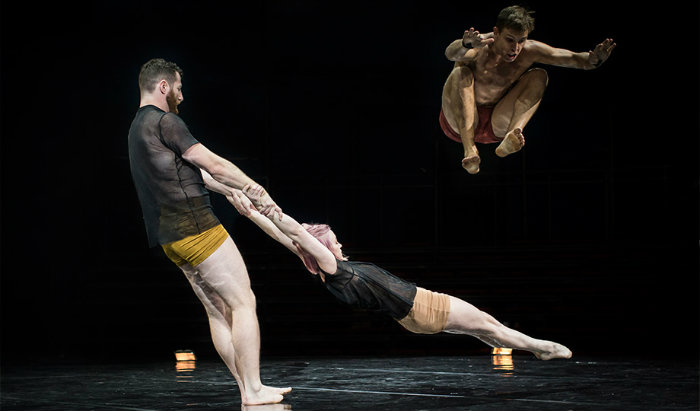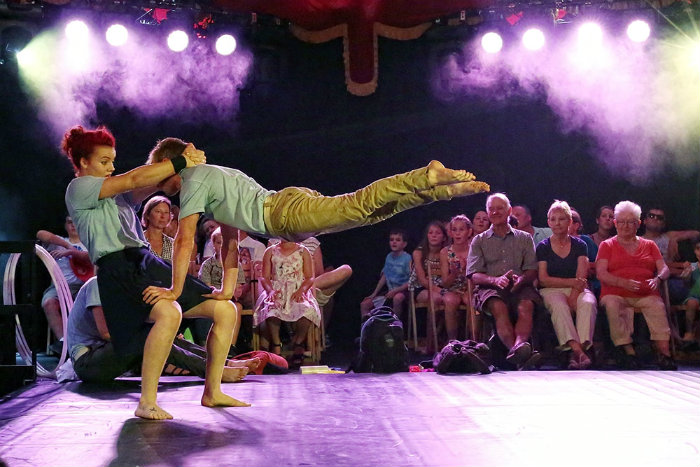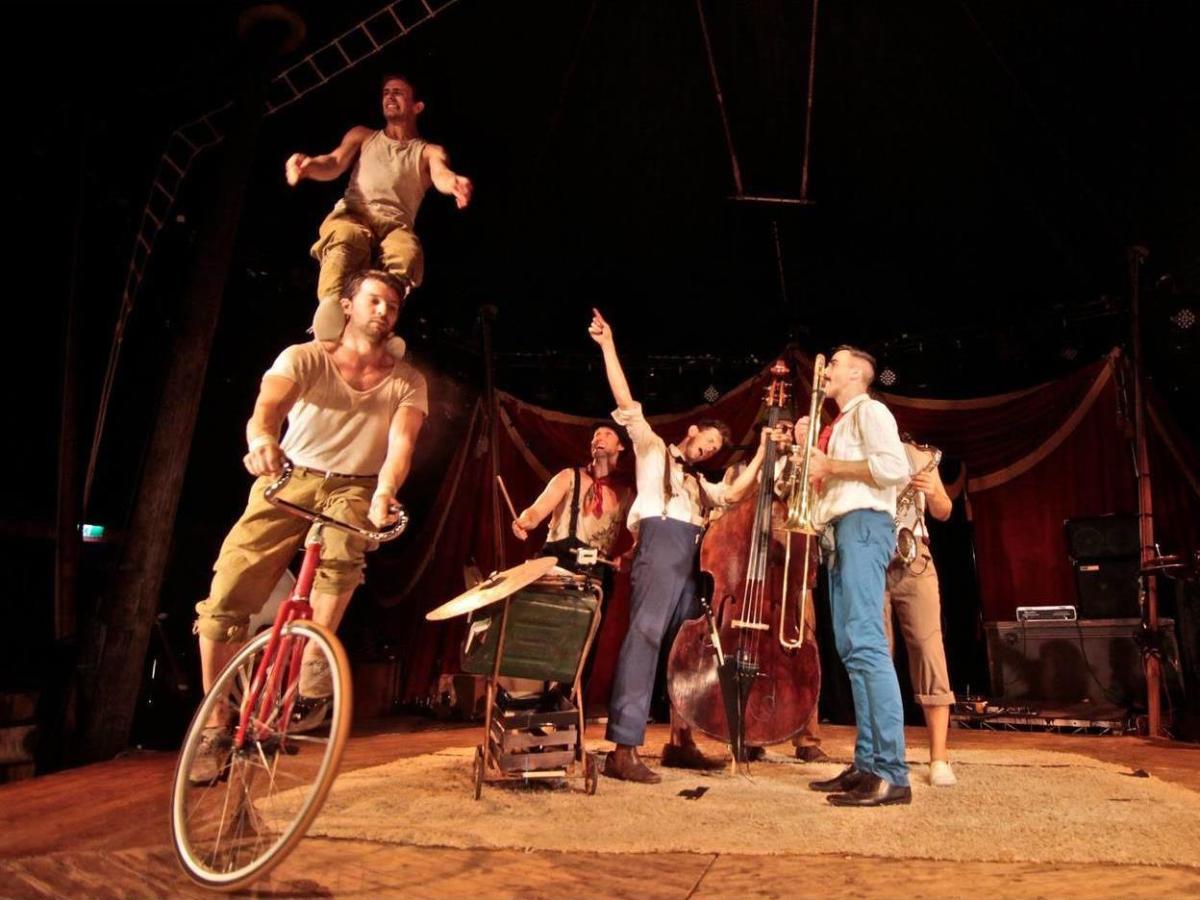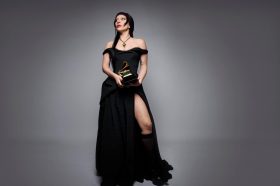Image: Company 2’s Scotch and Soda at Sydney Festival, 2014. Photo by Mik LaVage.
From humble beginnings, Brisbane’s circus sector is now internationally recognised. Companies such as Circa, Casus, and Company 2 are in high demand on the festival circuit, while the circus-burlesque hybrid Briefs Factory are also consistently acclaimed. Less recognised but no less important to the city’s ecology are community centres like Vulcana Women’s Circus and youth circus company Flipside, which provide training and opportunities for up and coming artists.
How did this rich circus ecology come into existence, and is its future secure? And to what extent is Brisbane’s status as an internationally recognised circus city based in fact – or is it all just hype?
‘When you look at the amazing, diverse range of work coming from Brisbane companies such as Circa, Briefs, Company 2, Vulcana, Hot Brown Honey, Flipside, Casus, and also Circus Stars, which is a social circus company working with young people with autism, the range and calibre of circus coming out of Brisbane is astonishing,’ said Dr Katie Lavers, a Sydney-based writer, director, producer and researcher, and co-editor with Peta Tait of The Routledge Circus Studies Reader.
‘It would be hard to over-inflate the cultural significance of the city as a vital and important circus hub,’ Lavers added.
Debbie Wilks, producer and director of Brisbane’s Cluster Arts, has firsthand experience of Brisbane’s global circus reputation. She said the city’s status as a home of world-class circus acts is far from exaggerated.
‘European audiences are excited by the work being produced by Brisbane circus companies – standing ovations, presenters and venues enthused by shows .. We were asked a number of times by people we met with including The Southbank Centre Underbelly Festival in London what was happening in Brisbane for there to be such a strong and successful physical theatre and circus representation,’ Wilks explained.
Rock ‘n’ Roll will never die
To discover why Brisbane has such a strong circus sector today, we have to look back at earlier decades, when Queensland was still ruled by the corrupt and heavy-handed Bjelke-Petersen government.
Antonella Casella is a Senior Artistic Associate at Circus Oz. Earlier in her career she was the founder of Brisbane’s Vulcana Women’s Circus and a founding member of Rock ‘n’ Roll Circus (now known as Circa).
‘There was a very fertile, radical political theatre movement in Brisbane in the late stages of the Bjelke-Petersen era,’ said Casella. ‘The key parts of that were probably Street Arts Community Theatre, which created the project which created Rock ‘n’ Roll Circus … and also 4ZZZ was also a very big part of that.’
Just as the involvement of community broadcaster 4ZZZ helped bands such as The Saints and The Go-Betweens flourish despite the heavy-handed tactics of the Queensland Police (as documented by Andrew Stafford in his 2004 book Pig City) Street Arts helped spawn a parallel movement in the performing arts.
‘And because Street Arts wasn’t just political theatre but community theatre, there was also a very strong sense of supporting emerging artists and people using circus and the arts not as a professional art form but as a way to express their personal stories, and their community’s stories,’ she said.
‘So I think it built a very sharing, supportive environment and that was all very much – at that time for circus – based around the Paint Factory in the West End. That’s where the first Rock ‘n’ Roll Circus shows were put on, and lots of subversive political cabarets were put on, as well as lots of community theatre shows made with specific communities. It was a very fertile time in Brisbane in the mid to late 1980s.’

Circa’s Humans; photo by Pedro Greig.
Lavers agrees that Street Arts played a key role in laying the groundwork for Brisbane’s current circus success, but argues that Casella herself also played a significant part in developing the city’s circus ecology.
‘Antonella … was one of Rock ‘n’ Roll Circus Circus’ founding members. She then went on to become a founder and the first Artistic Director of Vulcana, the women’s circus. Vulcana became a resident company at The Powerhouse at the invitation of then director Zane Trow and Casella opened up the space to other circus artists, creating a vital central training space. Some of the artists who trained with Vulcana, went on to form Flipside the Youth Circus company, and Company 2,’ Lavers explained.
In 2004, under Artistic Director Yaron Lifschitz, Rock ‘n’ Roll Circus was renamed Circa, and as Lavers notes, artists who worked with Circa such as Jesse Scott and Emma Serjeant went on to establish another Brisbane circus company, Casus. Serjeant has since moved on from Casus to establish another company, EmmaSerjeantPerformance (ESP).
‘So in a very direct way, the collaborative circus ecology in Brisbane shows a lineage springing out of the energy and commitment of those inspirational new circus and street theatre artists in Brisbane in the early 1980s, nearly 40 years ago,’ Lavers said.
Casella compares the impact of Street Arts on Brisbane to the influence of The Pram Factory on successive generations of Melbourne independent theatre-makers today. Both companies are long gone, but traces of their DNA can still be observed in the dynamic cultural landscapes that evolved in their wake.
One such trace can be seen in the ‘do-it-yourself’ attitude which Brisbane circus companies have to this day, said Wilks.
‘There is real sense of “just getting on with it,” that seems to set Brisbane apart as we don’t and can’t rely on funding and we prefer to use the model of doing it ourselves,’ she said.
Space and place
Brisbane’s geographic location, environment and even the climate have arguably also played a part in the local circus sector’s development. As dancers know, it’s easier to warm-up and train in a subtropical climate, and if you don’t have access to a venue, at a pinch a park will do.
As Casella explains: ‘I know from my own experience we trained frequently in Orleigh Park, which is one of the most beautiful parks in Brisbane, on the river, with the Queensland University on the other side of the river. You could just train there for weeks on end if you couldn’t get access to a venue. Although Brisbane has been very lucky in that from those Paint Factory days, there has always been a venue available for people to train in.’
Celia White, the current Artistic Director of Vulcana Women’s Circus, also credits Brisbane’s location as part of the key to its success as a home for contemporary circus.
‘It might be the location of Brisbane, which is outside the main centres but close enough to them that there’s cross-contamination if you like; there’s travel up and down the eastern seaboard but it’s still possible to survive as an independent artist,’ she said.
‘There are spaces available, too, which is where Vulcana comes in; spaces available to do your training and support to be making the work. And rents are relatively affordable – that might actually assist with the ability to take creative risks,’ she added.
The size of Brisbane compared to larger capitals like Sydney and Melbourne is both a positive and a negative for circus artists, said Wilks.
‘There is a lack of ongoing regular work in Brisbane and wider Queensland for our local companies and so to be sustainable companies need to tour internationally,’ she said.
‘There is also enormous collaboration and friendship amongst the circus community – the city is probably small enough for everyone to know each other but the respect for each other’s work is very real and not competitive – it’s healthy.’
Space to play
The collaborative nature of Brisbane’s performing arts sector is reflected in the ease of access to training and rehearsal spaces like those offered by Vulcana and Flipside.
‘Vulcana’s role in this is that we have a very nice circus space that we make available to all circus artists whenever we can,’ said White. ‘Whenever it’s not being used it’s available to artists to come and use … Anybody who’s working on anything can come and ask to use the space – and it’s very, very cheap – or ask to be supported in that work.
‘And as an unfunded company, currently, a new phase for Vulcana, one of our focuses now is supporting emerging artists. It’s something we’ve always done but that’s become kind of urgent for the organisation, and so we have been really focussing on incubators and various opportunities to skill artists up and providing performance opportunities regularly too … And Flipside have just started doing the same thing so there’s a residency structure and open access to the training space. We’re really creating opportunities for artists to come together to make work,’ White said.

Casus Circus’ Tolu. Image © Prudence Upton 2016.
Wilks noted that Flipside’s training space has been key to the development of a number of companies, including Company 2’s Kaleidoscope and Scotch and Soda, and Driftwood by Casus.
‘The Judith Wright Centre ran a successful program called Fresh Ground (until Arts Queensland canned it about 12 months ago). Out of this came a number of successful circus companies and their shows including Hot Brown Honey, Prying Eye’s White Porcelain Doll, and Knee Deep by Casus Circus,’ Wilks added.
Responding to Wilks’ comments regarding the axing of the Fresh Ground program, a spokesperson for the Premier and Minister for the Arts, Annastacia Palaszczuk, told ArtsHub: ‘Arts Queensland’s Judith Wright Centre of Contemporary Art plays a key role in championing the development of Queensland artists and celebrating and creating contemporary work and bold ideas.
‘To further support the development and presentation of new performing arts work at the Centre, Arts Queensland is currently procuring Creative Producer services. This role will work closely with Arts Queensland in managing the use of the Centre’s space and equipment in support of projects funded through the QASP Arts Ignite stream.
‘The Queensland Government is proud of the role it has played in supporting the growth of many arts organisations that are realising national and international acclaim,’ the spokesperson added.
Creative Producers
An additional factor in the development of Brisbane’s circus sector is the role played by circus-focused producers, such as Wilks and her colleague Kate Malone at Cluster Arts.
Another formative figure in this field is Scott Maidment, the Founding Director of production company Strut & Fret.
‘I don’t think you can ignore the contribution of Strut & Fret production house in that ecosystem [in the late 1990s],’ said Casella. ‘Scott was emerging as a circus producer in Brisbane around the same time that Vulcana had been going for a few years and Yaron was starting to develop a physical language for Circa, and he was able to then work with Vulcana and then with Circa and then later with Company 2,’ she said.
‘And then at the same time, Scott as a Brisbane-based producer created The Garden of Unearthly Delights in Adelaide with his colleagues. So a lot of Brisbane companies were involved with the growth of the Garden of Unearthly Delights in Adelaide and as a consequence involved with the London Wonderground and the Edinburgh Fringe. And you have to credit Scott in that whole process I think, it’s really important.’
Growing the circus sector nationally
Perhaps one of the biggest challenges facing the future growth of Brisbane’s circus sector is its size, which inhibits regular performance opportunities for local circus artists. However, this is not an issue that’s unique to the Queensland capital; it’s an issue of national concern, according to Casella.
‘There is no national touring circuit of any significance for contemporary circus in Australia, whether it’s from Brisbane, whether it’s from Melbourne, whether it’s from Adelaide. So what happens is, there’s an extraordinary international circuit and these companies, because of their calibre, are going straight into that,’ she said.
Without regular opportunities to put contemporary circus in front of audiences, it becomes harder to develop the art form’s status and the profile of local companies.
Yaron Lifschitz, the Artistic Director of Circa, notes that this is not an issue that’s exclusive to Brisbane – or even Australia.
‘I remember having a conversation with our friends at 7 Fingers in Montreal and I was bemoaning not touring in Australia and they were having the same experience in Canada. I think the exotic is appealing and the local is a bit harder to give the same aura. But patience and strategy and hard work seems to be turning things around,’ he said.
Lavers agrees, saying: ‘In terms of Australia, perhaps that lack of recognition can be seen as part of the widespread lack of recognition of the significance and importance of contemporary circus as a major art form on the world stage. In Canada and France for example, contemporary circus is recognised as a major art form of significance, on a par with dance and theatre and funded accordingly.
‘However attitudes to contemporary circus within Australia may start to shift with initiatives such as Circus City from Wesley Enoch, the Artistic Director of the Sydney Festival which is firmly positioning contemporary circus as a major component of the festival. In his program of international contemporary circus for the 2017 Sydney Festival, three of the selected shows came from Brisbane: Humans from Circa, Kaleidoscope from Company 2, and The Second Coming from Briefs, so hopefully contemporary circus, and Brisbane as a circus centre, will soon start to get more recognition within Australia,’ she said.
As well as inhibiting recognition of the art form, the lack of a national circus touring circuit – outside the network of Australian Fringe Festivals – is restricting the development of circus as an art form, said Casella.
‘It’s become a bit of a self-fulfilling cycle, in that the work is often geared towards the Fringe circuit. It’s work that is not funded and therefore it doesn’t have a lot of resources committed to high production values and it’s often work that is therefore created to draw a popular market – which is great, because of course one of the beauties of circus is that it’s popular. But I think that all of those things are kind of coming together to almost sideline circus in Australia as a bit of a fringe activity, whereas in fact internationally it’s not perceived that way at all.’
The lack of arts funding for circus companies is a particular concern for Casella.
‘There’s no funding so [circus artists] make the work in a very sustainable way and then it gives the impression that funding is not a critical part of the ecosystem but in fact it’s a major missing link, I feel, for small and independent companies,’ she concluded.




